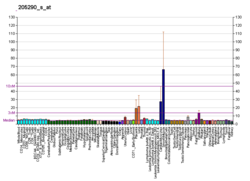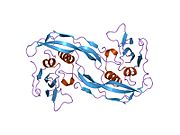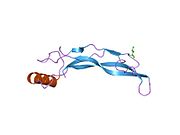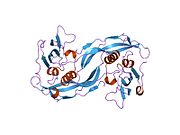Bone morphogenetic protein 2 or BMP-2 belongs to the TGF-β superfamily of proteins.
Function
BMP-2 like other bone morphogenetic proteins, plays an important role in the development of bone and cartilage. It is involved in the hedgehog pathway, TGF beta signaling pathway, and in cytokine-cytokine receptor interaction. It is also involved in cardiac cell differentiation and epithelial to mesenchymal transition.
Like many other proteins from the BMP family, BMP-2 has been demonstrated to potently induce osteoblast differentiation in a variety of cell types.
BMP-2 may be involved in white adipogenesis and may have metabolic effects.
Interactions
Bone morphogenetic protein 2 has been shown to interact with BMPR1A.
Clinical use and complications
See also: Bone morphogenetic protein § Clinical usesBone morphogenetic protein 2 is shown to stimulate the production of bone. Recombinant human protein (rhBMP-2) is currently available for orthopaedic usage in the United States. Implantation of BMP-2 is performed using a variety of biomaterial carriers ("metals, ceramics, polymers, and composites") and delivery systems ("hydrogel, microsphere, nanoparticles, and fibers"). While used primarily in orthopedic procedures such as spinal fusion, BMP-2 has also found its way into the field of dentistry.
The use of dual tapered threaded fusion cages and recombinant human bone morphogenetic protein-2 on an absorbable collagen sponge obtained and maintained intervertebral spinal fusion, improved clinical outcomes, and reduced pain after anterior lumbar interbody arthrodesis in patients with degenerative lumbar disc disease. As an adjuvant to allograft bone or as a replacement for harvested autograft, bone morphogenetic proteins (BMPs) appear to improve fusion rates after spinal arthrodesis in both animal models and humans, while reducing the donor-site morbidity previously associated with such procedures.
A study published in 2011 noted "reports of frequent and occasionally catastrophic complications associated with use of in spinal fusion surgeries", with a level of risk far in excess of estimates reported in earlier studies. An additional review by Agrawal and Sinha of BMP-2 and its common delivery systems in early 2016 showed how "problems like ectopic growth, lesser protein delivery, inactivation of the protein" reveal a further need "to modify the available carrier systems as well as explore other biomaterials with desired properties."
References
- ^ GRCh38: Ensembl release 89: ENSG00000125845 – Ensembl, May 2017
- ^ GRCm38: Ensembl release 89: ENSMUSG00000027358 – Ensembl, May 2017
- "Human PubMed Reference:". National Center for Biotechnology Information, U.S. National Library of Medicine.
- "Mouse PubMed Reference:". National Center for Biotechnology Information, U.S. National Library of Medicine.
- Sampath TK, Coughlin JE, Whetstone RM, Banach D, Corbett C, Ridge RJ, Ozkaynak E, Oppermann H, Rueger DC (August 1990). "Bovine osteogenic protein is composed of dimers of OP-1 and BMP-2A, two members of the transforming growth factor-beta superfamily". J. Biol. Chem. 265 (22): 13198–205. doi:10.1016/S0021-9258(19)38285-7. PMID 2376592.
- Chen D, Zhao M, Mundy GR (December 2004). "Bone morphogenetic proteins". Growth Factors. 22 (4): 233–41. doi:10.1080/08977190412331279890. PMID 15621726. S2CID 22932278.
- Marie PJ, Debiais F, Haÿ E (2002). "Regulation of human cranial osteoblast phenotype by FGF-2, FGFR-2 and BMP-2 signaling". Histol. Histopathol. 17 (3): 877–85. doi:10.14670/HH-17.877. PMID 12168799.
- ^ Jin W, Takagi T, Kanesashi SN, Kurahashi T, Nomura T, Harada J, Ishii S (April 2006). "Schnurri-2 controls BMP-dependent adipogenesis via interaction with Smad proteins". Developmental Cell. 10 (4): 461–71. doi:10.1016/j.devcel.2006.02.016. PMID 16580992.
- ^ Blázquez-Medela AM, Jumabay M, Boström KI (January 2019). "Beyond the bone: Bone morphogenetic protein signaling in adipose tissue". Obesity Reviews. 20 (5): 648–658. doi:10.1111/obr.12822. PMC 6447448. PMID 30609449.
- Nickel J, Dreyer MK, Kirsch T, Sebald W (2001). "The crystal structure of the BMP-2:BMPR-IA complex and the generation of BMP-2 antagonists". J Bone Joint Surg Am. 83-A Suppl 1 (Pt 1): S7–14. PMID 11263668.
- Kirsch T, Nickel J, Sebald W (February 2000). "Isolation of recombinant BMP receptor IA ectodomain and its 2:1 complex with BMP-2". FEBS Lett. 468 (2–3): 215–9. Bibcode:2000FEBSL.468..215K. doi:10.1016/S0014-5793(00)01214-X. PMID 10692589. S2CID 30068719.
- Kirsch T, Nickel J, Sebald W (July 2000). "BMP-2 antagonists emerge from alterations in the low-affinity binding epitope for receptor BMPR-II". EMBO J. 19 (13): 3314–24. doi:10.1093/emboj/19.13.3314. PMC 313944. PMID 10880444.
- Gilboa L, Nohe A, Geissendörfer T, Sebald W, Henis YI, Knaus P (March 2000). "Bone morphogenetic protein receptor complexes on the surface of live cells: a new oligomerization mode for serine/threonine kinase receptors". Mol. Biol. Cell. 11 (3): 1023–35. doi:10.1091/mbc.11.3.1023. PMC 14828. PMID 10712517.
- Urist MR (1965). "Bone: formation by autoinduction". Science. 150 (3698): 893–9. Bibcode:1965Sci...150..893U. doi:10.1126/science.150.3698.893. PMID 5319761. S2CID 83951938.
- Geiger M, Li RH, Friess W (November 2003). "Collagen sponges for bone regeneration with rhBMP-2". Adv. Drug Deliv. Rev. 55 (12): 1613–29. doi:10.1016/j.addr.2003.08.010. PMID 14623404.
- Khan SN, Lane JM (May 2004). "The use of recombinant human bone morphogenetic protein-2 (rhBMP-2) in orthopaedic applications". Expert Opin Biol Ther. 4 (5): 741–8. doi:10.1517/14712598.4.5.741. PMID 15155165. S2CID 45699304.
- ^ Agrawal, V; Sinha, M. (2016). "A review on carrier systems for bone morphogenetic protein-2". Journal of Biomedical Materials Research Part B: Applied Biomaterials. Early View (4): 904–925. doi:10.1002/jbm.b.33599. PMID 26728994.
- ^ Burkus JK, Gornet MF, Schuler TC, Kleeman TJ, Zdeblick TA (May 2009). "Six-year outcomes of anterior lumbar interbody arthrodesis with use of interbody fusion cages and recombinant human bone morphogenetic protein-2". J Bone Joint Surg Am. 91 (5): 1181–9. doi:10.2106/JBJS.G.01485. PMID 19411467.
- ^ Subach BR, Haid RW, Rodts GE, Kaiser MG (2001). "Bone morphogenetic protein in spinal fusion: overview and clinical update". Neurosurg Focus. 10 (4): 1–6. doi:10.3171/foc.2001.10.4.4. PMID 16732630.
- Allegrini S, Yoshimoto M, Salles MB, König B (February 2004). "Bone regeneration in rabbit sinus lifting associated with bovine BMP". Journal of Biomedical Materials Research Part B: Applied Biomaterials. 68 (2): 127–31. doi:10.1002/jbm.b.20006. PMID 14737759.
- Schlegel KA, Thorwarth M, Plesinac A, Wiltfang J, Rupprecht S (December 2006). "Expression of bone matrix proteins during the osseus healing of topical conditioned implants: an experimental study". Clinical Oral Implants Research. 17 (6): 666–72. doi:10.1111/j.1600-0501.2006.01214.x. PMID 17092225.
- Schliephake H, Aref A, Scharnweber D, Bierbaum S, Roessler S, Sewing A (October 2005). "Effect of immobilized bone morphogenic protein 2 coating of titanium implants on peri-implant bone formation". Clinical Oral Implants Research. 16 (5): 563–9. doi:10.1111/j.1600-0501.2005.01143.x. PMID 16164462.
- Richter R (2011-06-28). "Medtronic's spinal fusion product shown to be harmful in bold review by medical journal and its Stanford editors". Inside Stanford Medicine. Stanford School of Medicine. Archived from the original on 2012-04-23. Retrieved 2012-06-25.
- Carragee EJ, Hurwitz EL, Weiner BK (June 2011). "A critical review of recombinant human bone morphogenetic protein-2 trials in spinal surgery: emerging safety concerns and lessons learned" (PDF). Spine J. 11 (6): 471–91. doi:10.1016/j.spinee.2011.04.023. PMID 21729796. Archived from the original (PDF) on 2011-11-10.
Further reading
- Nickel J, Dreyer MK, Kirsch T, Sebald W (2001). "The crystal structure of the BMP-2:BMPR-IA complex and the generation of BMP-2 antagonists". J Bone Joint Surg Am. 83-A Suppl 1 (Pt 1): S7–14. PMID 11263668.
- Kawamura C, Kizaki M, Ikeda Y (2002). "Bone morphogenetic protein (BMP)-2 induces apoptosis in human myeloma cells". Leuk. Lymphoma. 43 (3): 635–9. doi:10.1080/10428190290012182. PMID 12002771. S2CID 42810021.
- Marie PJ, Debiais F, Haÿ E (2002). "Regulation of human cranial osteoblast phenotype by FGF-2, FGFR-2 and BMP-2 signaling". Histol. Histopathol. 17 (3): 877–85. doi:10.14670/HH-17.877. PMID 12168799.
External links
- bone morphogenetic protein 2 at the U.S. National Library of Medicine Medical Subject Headings (MeSH)
- Human BMP2 genome location and BMP2 gene details page in the UCSC Genome Browser.
| PDB gallery | |
|---|---|
|
| Cell signaling: TGFβ signaling pathway | |||||||
|---|---|---|---|---|---|---|---|
| TGF beta superfamily of ligands |
| ||||||
| TGF beta receptors (Activin, BMP, family) |
| ||||||
| Transducers/SMAD | |||||||
| Ligand inhibitors | |||||||
| Coreceptors | |||||||
| Other | |||||||
| TGFβ receptor superfamily modulators | |||||||||||||||
|---|---|---|---|---|---|---|---|---|---|---|---|---|---|---|---|
| Type I |
| ||||||||||||||
| Type II |
| ||||||||||||||
| Type III |
| ||||||||||||||
| Unsorted |
| ||||||||||||||













